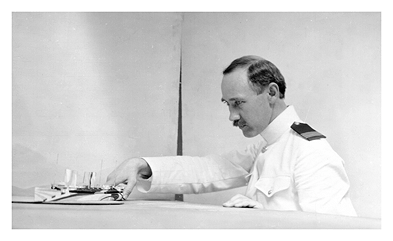Above This is a news photograph of American artist Charles Bittinger (1879-1970). We have blogged about him in the past because he was instrumental in US naval camouflage during both World Wars. 
Charles Bittinger (1946)
While trained at the École des Beaux-Arts in Paris, he was not a typical artist, because, as a graduate of MIT, he was equally interested in science, especially physics and optics. Among his achievements were projects in which he made use of both his artistic and scientific training, of which camouflage was one.
Incidently, he was also the half-brother of the Modernist painter John Marin. He was also a friend and colleague of American Impressionist and ship camoufleur Everett Longley Warner, and was probably responsible for Warner’s wartime assignment to ship camouflage.
This photograph was published in a front page news article (End of War Camouflage Seen By A-Bomb Artist) in the Honolulu Advertiser on May 19, 1946. Bittinger (who was in his late 60s at the time) was passing through Hawaii on government assignment. He was on his way to a test site on the Bikini Atoll, to paint on site the explosion of an atomic bomb. In an interview, he explained that “he would make a few sketch notes just after the missile falls but that most of his painting would be from memory.”
Earlier, Bittinger had taken on other related assignments. In 1937, while working with the National Georgraphic Society, he had painted on site a total eclipse of the sun, which lasted only four minutes. He had also experimented with painted murals that were made with fluorescent paint. When viewed under daylight illumination, they appear to one kind of picture, but look like a totally different scene when viewed in ultraviolet light.
RELATED LINKS
Dazzle Camouflage: What is it and how did it work? / Nature, Art, and Camouflage / Art, Women's Rights, and Camouflage / Embedded Figures, Art, and Camouflage / Art, Gestalt, and Camouflage / Optical science meets visual art / Disruption versus dazzle / Chicanery and conspicuousness / Under the big top at Sims' circus

















